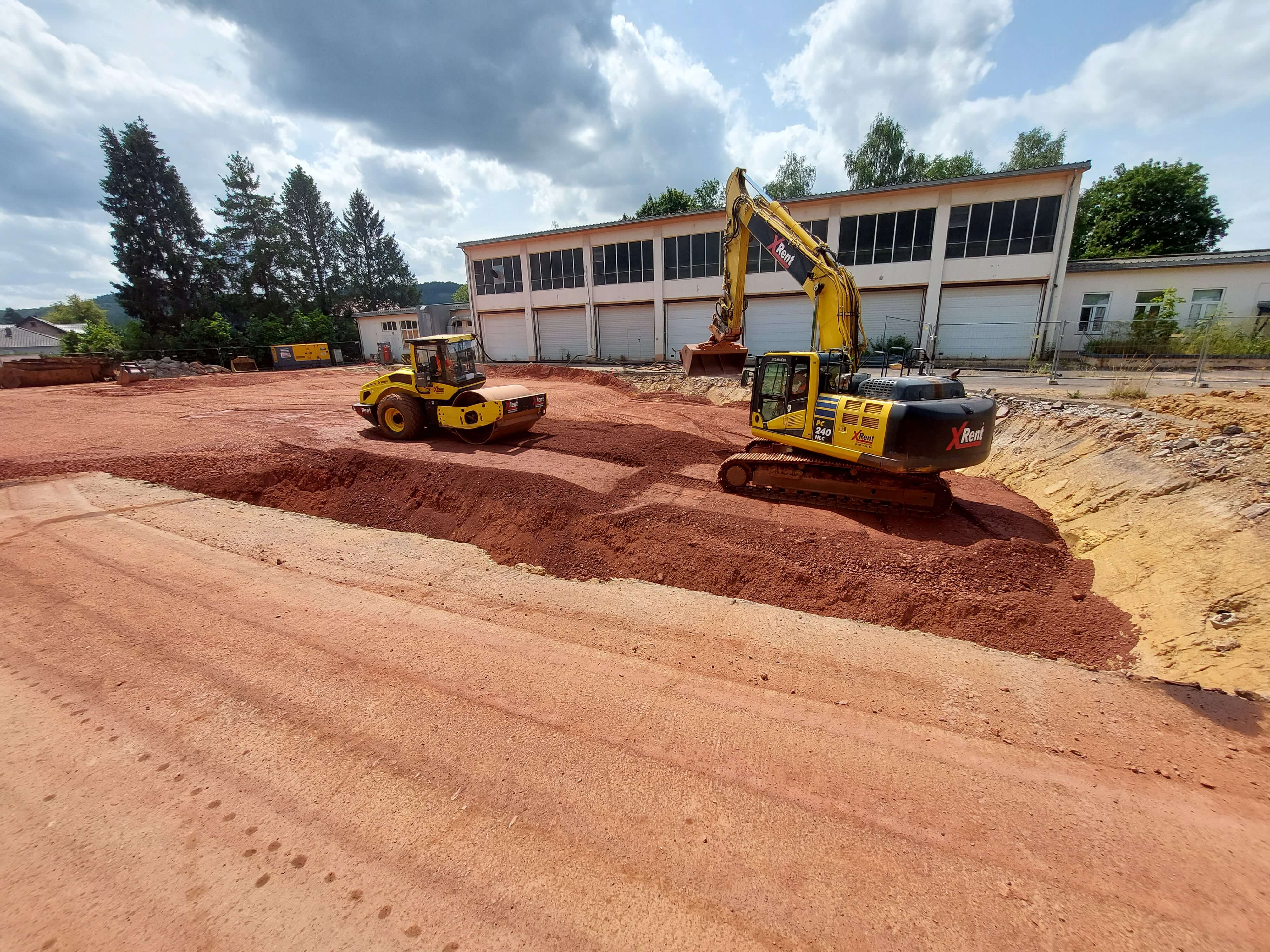A new urban district is being built on the approximately 25-hectare site of the former French "Barracks de Lattre". One component of this conversion project was the remediation of soil contamination with volatile aromatic hydrocarbons and, to a lesser extent, mineral oil in the area of a former petrol station in the barracks area. The soil contamination to be remediated is located in the area of the planned southern development of the development area via Schadallerstraße and is still owned by the Federal Real Estate Agency.
The entry area was a petrol station dating from 1952, although the petrol station had been in operation since 1955. Four double-walled underground tanks of 25 m³ each were installed in the petrol station area (built in 1955). The area of the petrol station, including the known contamination, was approx. 1,000 m². The petrol station was still in operation until the former tanks were cleaned up, but was taken out of service before 2010 and temporarily decommissioned.
In the course of various investigations carried out, soil and groundwater contamination by MKW and volatile aromatic hydrocarbons was identified and largely delimited horizontally and vertically.
The soil contamination by BTEX aromatics and methylbenzene extended from the point of entry (tanks, tank island) to different depths in the unsaturated soil zone. Particularly in the southern area of the contamination site, the contamination extended into the saturated soil zone. The contamination by BTEX and methylbenzenes extended to a depth of approx. 7.50 m below ground level.
Mull und Partner Ingenieurgesellschaft began the remediation planning for the high-load area in 2022 on behalf of the Federal Agency for Real Estate. The aim was to remediate the defined contamination area up to approx. 7.50 m below ground level, including the dismantling of the underground tanks and tank technology systems. The neighbouring buildings directly to the west were to be preserved and the sensitive surroundings (residential area with day care centre) were to be protected. In addition, the damage caused by artillery fire during the Second World War would have to be taken into account when designing the redevelopment.
As part of the remediation planning, a two-stage process was developed for the remediation of the source. Firstly, the tanks, including the tank technology systems, were to be removed by means of conventional excavation in a sloped excavation pit and a source remediation up to 5.0 m below ground level was to be carried out. In a second phase, it was planned to remediate the contamination in the load transfer area of the existing buildings and in the deeper remediation horizon by means of overlapping large boreholes.
In addition, as part of the remediation planning, a clearance concept was drawn up for dealing with the contamination caused by artillery fire and the early exploration and clearance measures were tendered and monitored. Furthermore, due to unclear pipe locations within the remediation area, search shafts were dug to locate the pipes.
Both measures were aimed at achieving the greatest possible construction freedom for the renovation measures, in particular the special civil engineering work, in the run-up to the renovation and thus minimising downtimes due to unforeseeable circumstances.
As part of the remediation planning, extensive waste and geotechnical investigations were also carried out in the remediation area. The technical waste investigations were used for the basic characterisation of the excavated material produced in the course of the remediation with the aim of avoiding provision for declaration in the course of the actual remediation measure and thus protecting the neighbouring residential area from the volatile pollutants. The geotechnical investigations provided soil parameters for the design of the backfilling of the large boreholes in the load transfer area of the existing building.
Based on the refurbishment planning, the implementation planning and the tendering of the refurbishment measure took place in January 2023. Mull und Partner Ingenieurgesellschaft Hannover accompanied the tendering and award procedure for the refurbishment measure.
STRABAG Umwelttechnik GmbH was awarded the contract for the renovation work in April 2023. The refurbishment was carried out between 05/2023 and 08/2023.
The specialist construction supervision and site management was carried out in collaboration with Mull und Partner Ingenieurgesellschaft Hannover and Taberg Ingenieure GmbH Trier branch. The colleagues from Trier took over the local construction supervision in close coordination with the construction management of Mull und Partner Ingenieurgesellschaft Hannover.
In the course of the renovation work, the asphalt and concrete pavement in the renovation area was first demolished. The resulting demolition materials were recycled. This was followed by the uncovering and dismantling of the four 25,000 litre underground tanks as well as the underground pipe systems and foundations of the former petrol station. In the course of the conventional soil replacement, the surface sealing and the underground tank systems were removed. In addition, soil was replaced up to 5.0 m below ground level in an open excavation pit in the core remediation area.
Subsequently, the deeper-lying load was replaced up to 7.50 m below ground level by means of overlapping large boreholes. These were carried out from a working level 0.50 m below ground level. A total of 173 large boreholes were drilled. These are broken down as follows:
71 boreholes up to 7.0 m and working level ® 7.50 m above ground level
63 Boreholes up to 5.5 m and working level ® 6.00 m above ground level
39 Boreholes up to 4.5 m and working level ® 5.00 m above ground level
In the course of the remediation, 9,531.96 tonnes of soil were disposed of as hazardous waste.



